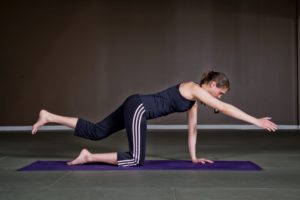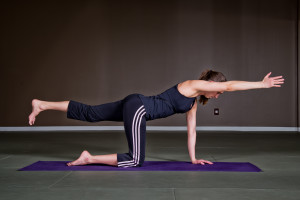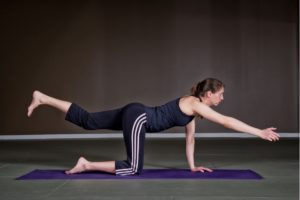Exercises for Lower Back Pain
Banish Lower Back Pain by Exercising These 3 Muscle Groups
Do you have lower back pain or does your back feel tight? Maybe you have had an episode of lower back pain and NEVER want to experience that feeling again? I work with patients every day to build strong, stable backs not vulnerable to injury. Strengthening the three muscle groups listed below is the key to banishing lower back pain for good.
1. Work the Core to Prevent Lower Back Pain
Obviously, this buzz word “core” is not a stand alone muscle but a group that must work together to protect against lower back pain.
Specifically in this group, I’d like to take a look at the Transverse Abdominals (TAs), Internal Obliques and Multifidi. These muscle groups are key for stabilizing the spine along with many others. Muscles such as the Rectus Abdominis (6 pack muscle), Erector Spinae (the ones that makes your back feel tight), and the External Obliques are movers of the spine, not primary stabilizers.
When you feel lower back pain, it’s because your stabilizers take a break and your movers overwork. Someone has to do the stabilizing and movers cause pain when they take over. If you have lower back pain or your back feels tight frequently, then you are probably overusing your movers. It’s time to stabilize!
Key #1 for preventing lower back pain is making sure all your stabilizers are firing, includes TAs, quadratus lumborum and internal obliques. I like to think of the TAs as bracing muscles, they wrap around your entire torso like a corset. These are the muscles you would tighten if someone were going to punch you in the stomach. Still can’t find them? Try coughing, then hang on to that tightness the cough created.
My favorite way to train the TAs to brace is to lie on your back with your knees bent. Make sure to relax your back. Neutral spine (do not tuck your butt under!), shoulders back, do not engage hamstrings or hip flexors. Now, push your fingers gently into your side and “brace” or tighten your TAs to prevent your hands from going in. Work on being able to hold these muscles tight and breathe all while keeping your lower back relaxed.
Finding Spinal Neutral:
This is the place where you are not pressing your back flat and you are not overarching. The comfortable place that supports your NORMAL spinal curve. If you overarch or push your back flat your disrupt your normal curve. It’s important to train in neutral.
Best way to check for spinal neutral is to place your palms on the top of your hips (ASIS) and your fingers in your pubic bone, they should be about even. As you can see in both of the above pictures if I had my hands on my pelvis they would be tilted either up or down.
Muscle #2
Muscle #2 of the core that I want to highlight for preventing lower back pain is the Multifidi. These small muscles attach to each spinal segment and stabilize against the pull of the obliques. They are key to preventing shearing of the disc.
The best way to train the Multifidi is an opposite arm/leg lift. Get on your hands and knees. Chin tucked, head up in line with your body, hips in neutral, shoulders directly over your hands. Start with your “abdominal brace” that you learned above. (No rounding up when you tighten.) While holding your TAs, lift your opposite arm and leg just a little without moving or shifting a millimeter. Pretend there is a full cup of water on your back.
Once you get these two muscles firing, it’s off to the races. Planks, hanging abs, and other crazy abdominal exercises are fair game! And the best part is with these key muscles working your back will never feel tight again.
Check out my favorite hard core training exercises.
2. Glutes
The Glutes are incredibly important for preventing lower back pain. When referring to the glutes I’m talking about the Gluteus Medius, Minimus and Maximus.
The Glute Medius and Minimus play a larger role in stabilization while the Glute Max is our powerhouse. Without proper stabilization (yes, back to those stabilizers again) the pelvis will have excessive movement. What do you think sits in the pelvis? The sacrum sits in your pelvis, which is the base of your spine. So, if your base is unstable it will make your spine unstable, causing lower back pain.
My favorite exercise for building strong hips is a squat with a good hip hinge.
This hip hinge is key to preventing lower back pain every time you bend over and we bend over a lot in life. (Dishwashers, washing machines, stuff on the floor, etc.)
Start by learning a simple hip hinge:
See how in picture 1 my back stays in neutral and in picture 2 it’s curving?
Think about this next time you wash your hands. Do you hunch for the sink or protect your neck and back by hinging?
Learn how to do a proper squat.
To do a correct squat, keep your head in line with your body. Tight your core (TAs) and sit back into a chair. Keep your knees in line with your feet and your feet in line with your hips. If you let your knees cave in, it will effect the alignment of your patella (knee cap) and cause knee pain.
If you are having trouble getting your core to fire then press your hands gently into your sides during the whole squat just like you did learning how to contract your TAs. Do not relax your core at any point during the exercise. This will ensure you are braced properly to prevent all future lower back pain! Once you know your core is contracting properly you can hold your arms up in front of you for counter balance weight.
Trouble Shooting:
If you are having trouble getting your glutes to fire, try putting a band around your knees and pressing out. This will help turn on the glutes and banish lower back pain forever!
For an advanced hip hinge exercise try a dead lift. If done improperly, this exercise can cause severe lower back pain and stress but when done correctly, it has amazing benefits.
3. Lats
Who knew that the more pull-ups you could do the safer your lower back would be? Crazy right?! Well, those giant upper body muscles that pull you up come down and attach to a big fascial band that runs across your lower back. (The TAs also attach into this band.) When the lats contract they pull on this band, providing tension to help support your spine and disc preventing lower back pain episodes.
My favorite way to work this muscle is band pulls. Place a band over the door or tie it to a pull-up bar. Turn sideways and do a small squat or hip hinge, contract your TAs by corseting then pull down thinking of pulling your elbow toward your side. Keep your shoulder down and away from your ear. If you are having trouble relaxing your grip try tying the band around your wrist or elbow. Do not let your back scrunch or help you pull, if you do it means you are not corseting enough. Now you are well on your way to doing loads of pull-ups correctly!
Click here to read about this exercise in depth.
Once you get these key muscles working, your lower back is going to feel great. There is no better feeling in life than being in shape, strong and healthy. A great workout makes you feel like you can take on the world.
Working with pregnant and postpartum clients/patients?
This 6-part course offers key takeaways on breathing, pelvic floor strengthening and diastasis recovery. Sign up and start learning today!

















